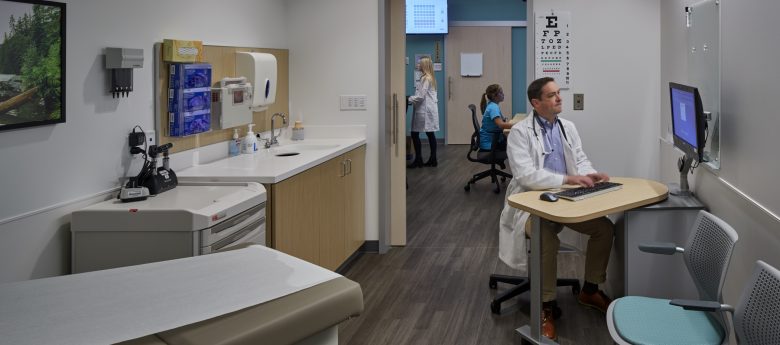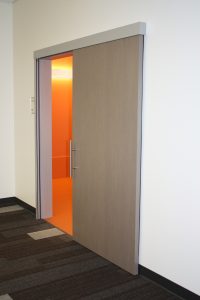Long Live Privacy in Healthcare Facilities & Schools

As social networking, digital visibility and apps with location-based services become the norm, security pundits and researchers are questioning the relevancy of privacy. Jacob Morgan, Forbes contributor, puts it, “Privacy…everyone is talking about it and apparently everyone is concerned with it, but going forward does it even matter?” 1
While the answer to this question is hotly debated in the digital world, offline the answer is a resounding “yes!” This is particularly true in healthcare facilities and educational occupancies, which are subject to federal laws and privacy standards. Who among you, for example, would want to be overhead discussing a medical condition with your doctor, or have students eavesdrop on your child’s guidance counselor discussion?
Given the importance of privacy in healthcare and school environments, design professionals seek material solutions that mitigate sound transfer. An area of emphasis is interior doors – one of the weakest links in a wall assembly. By nature, doors and openings have lower sound attenuation than the surrounding wall. This is largely due to the fact that walls are thicker and multilayered, whereas doors can leave gaps that allow sound to travel into or out of a space.
To seal the hole in the wall and help control sound, design professionals have two primary choices: swing doors and sliding doors. Swing doors require a significant amount of space for the swing of the door and approach clearances; however, they have been the historical solution of choice due to challenges with sealing the perimeter of sliding doors. Manufacturing advances are now leveling the playing field. Next generation sliding doors provide a level of acoustic separation fit for healthcare and educational occupancies, allowing design professional to tap into their space-saving and design benefits.
What Changed?
For years, sliding doors ranked lower than traditional swing doors in their Sound Transmission Class (STC) and Noise Isolation Class (NIC). In large part, this was due to the difficulty of sealing all sides of a sliding door in the closed position, which resulted in leaky gaps for noise transfer.
However, this all changed with the advent of acoustic gaskets and drop-down bottom seal features. These mechanisms now make it possible to seal all four sides of a sliding door leaf, resulting in a tight perimeter with excellent sound abatement properties. For example, sliding door assemblies with these features are on par with swing doors, providing NIC values up to 39. This meets or exceeds the Facility Guidelines Institute’s STC 35 target for speech privacy in exam rooms.
In addition to providing privacy for private conversations, sliding doors with a high level of sound attenuation are well equipped to reduce outside noise transmission through spaces, for a more enjoyable interior environment. This is a key factor in a host of settings as research shows that noise is not just a nuisance to people but can be a detriment to their wellbeing. In fact, in healthcare facilities, it has been found that noise can negatively impact patients and staff, from elevating heart rate and blood pressure to causing employee burnout. 2
Privacy and Beyond
By overcoming the longstanding acoustic roadblock, design professionals can now use specialty sliding doors to bring privacy in line with the unique needs of healthcare and educational occupancies.
 Acoustic Privacy and Occupant Wellbeing
Acoustic Privacy and Occupant Wellbeing
Acoustic privacy is a serious matter in educational and healthcare occupancies. As vitamin-D reliant beings, so too is the provision of daylight. Research shows that daylight has a positive influence on student performance and can expedite healing. In fact, a study by The Center for Health Design found that, “By controlling the body’s circadian system, light impacts outcomes in healthcare settings by reducing depression among patients, decreasing length of stay in hospitals, improving sleep and circadian rhythm, lessening agitation among dementia patients, easing pain, and improving adjustment to night-shift work among staff.”
To combine acoustic privacy with light transfer, sliding doors are available in wood or metal frames with a range of clear glazing options, including glazing for X-ray rooms, integral blinds or switchable glazing for enhanced privacy options. With a top-hung mount and slim frame profile, they preserve sightlines, creating truly bright, open and porous doorways and interior storefronts. To further extend light transfer, single or bi-parting pairs of sliding doors with fixed sidelites and transoms are also available.
Of course, while a high level of light transfer is desirable in many situations, in others, an element of visual privacy is necessary. Consider universities with distraction-free writing zones or hospital waiting areas and conference rooms. In these instances, sliding doors with semi-transparent glass are available as a privacy control. They can prevent occupants from feeling exposed and vulnerable while still diffusing light to interiors. In sensitive areas where complete visual and acoustic privacy is necessary, as in exam rooms, wood is still the preferable choice.
Acoustics and Space Efficiency
Space efficiency is crucial in many building types, but in few occupancies is it more important than in schools and hospitals. Students and staff fill school hallways, corridors and space-restricted restrooms in multitudes throughout each day. Medical personnel in hospitals face a throng of incoming patients, fast-moving gurneys and a new set of emergent situations by the hour. Sliding doors can help free up limited square feet in these environments without comprising acoustics. In fact, by removing the arc of space needed for swing doors to open, sliding doors can provide an additional 30 square feet of usable room. This extra space was paramount in the expanded and refurbished emergency department (ED) at Mountain View Hospital in Payson, Utah.
“It was critical that we create transparency in the ED so that everyone – doctors, nurses, staff and patients – can look around and immediately see what’s heading their way,” said Nathan Murray, Design Principal of TSA Architects (Salt Lake City, Utah). The sliding doors “enabled us to maximize the space in an efficient way, so we could achieve a fluid environment that can respond to the fluctuating levels of demand placed on it at any given time.”
The efficiency afforded by sliding doors is also essential to making dual entry exam rooms successful in healthcare facilities. In these rooms, patients enter from a public-facing “patient door” while medical personnel enter from a “provider door.” Sliding doors remove the considerable area needed for two door swings in these small rooms, while providing adequate acoustic privacy for both the patient exam and collaborative medical space situated behind the exam room.
ADA Compliance
In many occupancies, including in healthcare facilities, doors must also comply with requirements in the Americans with Disabilities Act (ADA). These apply to the hardware, operating force and clearances. While it was once challenging to comply with these needs, manufacturers now offer a range of hardware solutions to meet current accessibility requirements. These include ADA thumb turn locks with occupancy indicators, key locks, self-latching mortise, card reader access, single-action egress with lever, and more. As an added benefit, top-hung sliding door assemblies without an exposed floor track improve accessibility and simplify cleaning. Optional automatic operators can further enhance accessibility.
With ADA-compliant operation, ease-of-access and space efficiency, specialty sliding doors provide people of all ages and abilities with an easily moveable door and efficient access to and from the room.
Privacy may be a choice in the online world, but in healthcare and medical settings, whether for federal laws or information disclosure acts, it is a real and serious need. With new innovations in sliding glass doors, it is now possible to provide this safeguard in a space-saving, ADA compliant and occupant-focused manner.
Tysen Gannon, LEED AP, is director of business development for AD Systems. Gannon has more than 15 years of experience in the architectural products industry, including roles in sales, product management, research and marketing, with a focus on glass and glazing, fenestration and façade systems. Visit www.specadsystems.com to learn more.
1 Morgan, Jacob, Privacy Is Completely And Utterly Dead, And We Killed It, Forbes.com. www.forbes.com/sites/jacobmorgan/2014/08/19/privacy-is-completely-and-utterly-dead-and-we-killed-it/#241dca9e31a7
2Joseph, A. and Ulrich, R. Sound Control for Improved Outcomes in Healthcare Settings. The Center for Health Design. January 2007. Web. 9 November 2016. www.healthdesign.org/sites/default/files/SoundControl.pdf.
